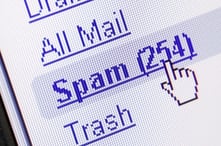

J&C Blog
Find all the latest marketing trends on the J&C Blog.

Find all the latest marketing trends on the J&C Blog.
Have you often wondered what is considered email spam by the user? In this case, I’m not referring to actual email deliverability. This article hypothesizes about emails that end up in a user’s email inbox, but is a communication that the user considers as unwanted email. 
According to Wikipedia, the technical definition of spam email is junk email or unsolicited bulk email. Spam is further defined as sending nearly identical messages to numerous recipients by email. I’d argue that users consider spam as any unwanted email. This includes unsolicited emails from unknown senders or any company they don’t perceive as having a relationship with currently.
According to ZDNET, the worldwide spam rates fell 2.5% to 69.6% of email flows in 2013. ZDNET further reported that the number of emails with malicious attachments fell 0.2% for the year to 3.2%. For the purposes of this article, the focus will be on email that is perceived as spam, but was legitimately sent, not email with malicious intent, links, etc.
Does making a purchase qualify as having a relationship?
A debate I often hear from marketers and their organizations is what constitutes an opt-in email address. The email facts around this debate surprised me. It turns out that 77% of marketers feel that a purchase constitutes marketing permission.1 Unfortunately, 1 out 4 consumers do not believe that it’s OK for a company to start sending promotional emails if the consumer purchased something from the company, because the consumer didn’t specifically sign up to receive emails from them. This discrepancy is both surprising and alarming for marketers.
Marketers must work to ensure buyers are aware that post-purchase they will now receive communications. Marketers should ensure messaging is integrated in their confirmation emails to protect the company, and alert purchasers that they’ll receive future communications. Include clear language and set expectations understanding that your view and the user’s view might not be identical.
Why do people unsubscribe?
One consideration is whether unsubscribes can be equated to perceived spam by the user, or unwanted email. It does appear that unsubscribing is directly related to perceived value of email messaging and relevancy. 52% of consumers receiving emails from retailers last holiday season unsubscribed from at least one. Of those who unsubscribed, 37% said content of the emails weren't relevant. Interestingly, nearly one out of five reported never subscribing for the email updates.2 These email facts demonstrate the possible tie between the perceptions of unwanted emails and unsubscribes.
Relevancy overcomes the perception of spam.
It has been hypothesized that marketing fatigue can occur if users receive too many irrelevant communications. However, a user will be more accepting of a larger volume of communications if they feel the communications are relevant and speak to their needs.
Slightly more than half of user’s state that the reason they have opted out is because of message frequency.3 Delivering successful email marketing campaigns may become dependent on leveraging marketing data to deliver relevant communications that are sent in a higher volume than was once believed would be tolerated. The key, however, is using and applying data to create communications that are relevant—things the user wants to engage with and values.
Adobe recently validated this finding in its Fighting Marketing Fatigue white paper. The white paper noted that marketing fatigue is not measured by actual communication frequency, but “perceived frequency.” This led to a revolutionary finding: that marketers can safely increase the number of communications without fatiguing a target audience if communications are uniquely personalized at an individual level. I believe these findings directly tie to user perceptions of unwanted email.
Do you think your email marketing is considered spam or valued by recipients? Do you have best practices in place for ensuring your email database is aware that they’ll be receiving future email communications? Email marketing is continuing to grow as one of the most utilized and most effective channels.
To learn more about how to take your email marketing to the next level, sign up for J&C’s email marketing assessment. We’ll review your current email approach and help you enhance the relevancy and value of your email marketing communications.
Sources:
1. RegReady, "Perceptions of Marketing Permission," (2013)
2. StrongMail, "Email Remains the Leading Driver of Holiday Purchase Decisions," (2013)
3. BlueHornet, "2013 Consumer Views of Email Marketing," (2013)
Topics: Email Marketing
303 E Wacker Drive, Suite 2030
Chicago, IL 60601
Phone: 312-894-3000
Fax: 312-894-3005